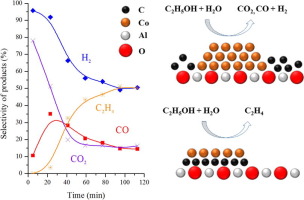Journal of Catalysis ( IF 6.5 ) Pub Date : 2017-12-19 , DOI: 10.1016/j.jcat.2017.12.003 Zs. Ferencz , E. Varga , R. Puskás , Z. Kónya , K. Baán , A. Oszkó , A. Erdőhelyi

|
The steam reforming of ethanol was studied at 823 K on 10% Co/Al2O3 samples calcined at 973 K and reduced at different temperatures from 773 K to 1173 K. The catalysts were characterized by XPS, XRD, TPR, Raman and DRIFT spectroscopy. XRD results revealed that spinel structures are detectable after the thermal treatment of Co/Al2O3, which could be attributed mainly to Co3O4 formation. TPR and XPS measurements show that even the high temperature (1173 K) reduction is not sufficient to totally reduce Co to metallic state.
The ethanol conversion at 823 K was relatively stable and it was higher than 90% in all cases, but the product distribution as a function of time on stream significantly depended on the reduction temperature. The selectivities of H2, CO2, and CH4 formation decreased in time but those of ethylene, acetone and acetaldehyde increased. The changes became less pronounced when the reduction temperature increased, so the H2, CO, and CO2 selectivities increased while that of ethylene decreased significantly as a function of reduction temperature.
XPS measurements revealed a new low binding energy state in the Co 2p3/2 region during the reaction when the samples were reduced at or below 973 K. This feature was assigned to the formation of a very thin Co layer.
On the used catalysts reduced at or above 973 K structured carbon was detected. On the XP spectra several carbon species were identified at the beginning of the reaction. A new feature was also found at lower binding energy which became more and more dominant with the exception of Co/Al2O3 reduced at 1173 K. These species could be assigned as CoCx carbide-like structures rather than a structured carbon layer.
It was found that the surface carbon formed in the reaction gradually influences the product distribution. The carbon which probably is built in the Co subsurface poisons the reactivity of the metal and the effect of the support comes in the forefront. The structured carbon layer formed on the Co/Al2O3 reduced at high temperature does not influence the hydrogen formation in the ethanol reforming.
中文翻译:

在不同温度下,乙醇在Co / Al 2 O 3催化剂上的重整反应减少
在823 K煅烧973 K的10%Co / Al 2 O 3样品上于823 K研究了乙醇的蒸汽重整,并在773 K到1173 K的不同温度下还原了乙醇。光谱学。XRD结果表明,在对Co / Al 2 O 3进行热处理后,可以检测到尖晶石结构,这主要归因于Co 3 O 4的形成。TPR和XPS测量表明,即使高温还原(1173 K)也不足以将Co完全还原为金属态。
乙醇在823 K的转化率相对稳定,在所有情况下均高于90%,但是产物分布随时间的变化明显取决于还原温度。H 2,CO 2和CH 4形成的选择性随时间降低,而乙烯,丙酮和乙醛的选择性则增加。当还原温度升高时,该变化变得不那么明显,因此H 2,CO和CO 2的选择性随着还原温度的升高而显着降低,而乙烯的选择性则显着降低。
XPS测量显示,当样品在973 K或以下还原时,反应期间Co 2p 3/2中出现了新的低结合能状态。该特征与非常薄的Co层形成有关。
在使用过的催化剂上,检测到还原度为973 K或更高的结构化碳。在XP光谱上,在反应开始时发现了几种碳。还发现了一个新特征,即较低的结合能变得越来越重要,除了Co / Al 2 O 3在1173 K时还原。这些物质可以被指定为CoC x碳化物状结构,而不是结构碳层。
发现在反应中形成的表面碳逐渐影响产物的分布。可能埋藏在Co地下的碳会毒化金属的反应性,而载体的作用就位居前列。在高温下还原的Co / Al 2 O 3上形成的结构化碳层不影响乙醇重整中的氢形成。











































 京公网安备 11010802027423号
京公网安备 11010802027423号